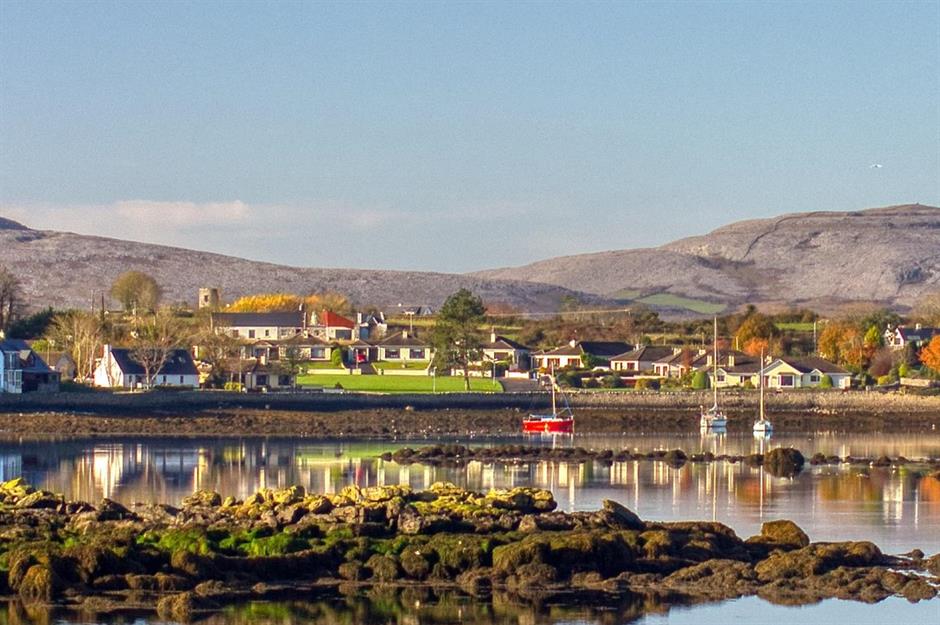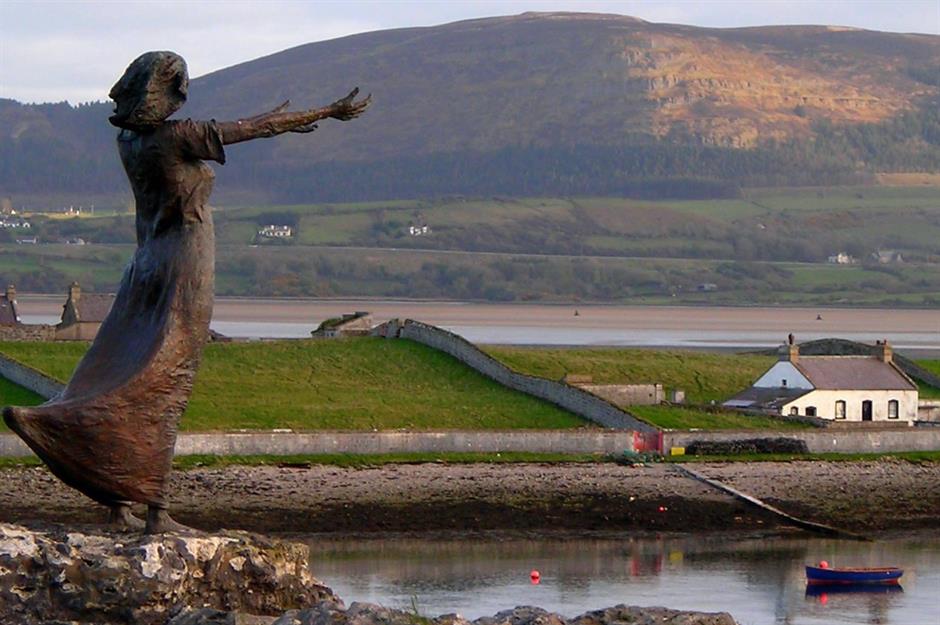Ireland’s most beautiful small towns and villages
Picture-perfect places
Rosses Point, Sligo
Views of Coney Island and Oyster Island add to the charm of this village and peninsula in County Sligo, set against the backdrop of the spectacular Dartry mountain range. Writer William Butler Yeats and his younger artist brother Jack spent summers at Elsinore House, inspired by the local scenery. Notable landmarks include the Metal Man lighthouse built in 1921 at the entrance to Sligo Harbour. More recently, in 1985, archaeologists have uncovered shipwrecks of the Spanish Armada here, dating to 1588.
Baltimore, Cork
Cashel, Tipperary
An imposing archaeological site towers over this small southern Ireland town, which includes a Gothic cathedral, a round tower and a 15th-century castle. Fascinating museums nearby at Cashel Folk Village explore the Great Famine and the 1916 Easter Rising, while the Brú Ború cultural centre hosts concerts and performances.
Love this? Follow our Facebook page for more travel inspiration
Bundoran, Donegal
Ireland’s self-styled surf capital offers sandy beaches and cute coves at the most southerly point of Donegal, with the Atlantic swell luring surfers from around the world. There are also fun-filled attractions, from a classic big wheel to amusement arcades. Further along the coast, Tullan Strand is two miles (3.2km) of cliff-backed beach. Each June, Bundoran’s Sea Sessions surf and music festival is a sell-out beach party where artists from Groove Armada to Kasabian come to play.
Cobh, Cork
This charming small town, pronounced 'cove', sits on a sparkling estuary dotted with brightly painted shops and homes presided over by the slender spired neo-Gothic St Colman's cathedral. Aside from architectural charm, Cobh (formerly Queenstown) is famed for its past – it was the final port of call for the Titanic and a poignant museum commemorates the fatal voyage's last point of departure.
Unlock more Titanic secrets at these incredible dedicated museums
Dalkey, Dublin
One visit to this seaside village – which appears to tumble towards the sea – explains why it has been home to writers and artists including George Bernard Shaw, Maeve Binchy, Robert Fisk, Bono and Van Morrison. With two Norman castles, good looking pubs, slender lanes lined with book shops, restaurants and delis, and paths leading down to the striking coastline, what's not to like? Best of all, it’s only half an hour from Dublin city centre, making it an ideal day trip.
Dingle, County Kerry
It’s not surprising that tourists flock to this naturally charming fishing port and the only town on the Dingle Peninsula. Despite the summer crowds, Dingle retains its tradition and is a designated Irish-speaking region – or Gaeltacht. Dingle is also famed for its unusual hardware pubs, where you can buy a pint and a picture frame. Beyond the town you'll find rugged scenery and dramatic cliffs and the Gallarus Oratory, an ancient dry-stone church with sloping sides.
Dungarvan, Waterford
Dungarvan perfectly packages up a pretty waterfront, historical sights and quaint streets set against the backdrop of the Comeragh Mountains. Visit the Norman castle with its polygonal shell keep and the craft brewery, which produces golden and pale ales. Waterford Greenway, an old railway line from Waterford City to Dungarvan, reimagined as Ireland’s longest off-road walking and cycling route, passes through idyllic scenery.
Letterkenny, Donegal
This lively 17th-century market town charms with a grand neo-Gothic cathedral, cute market square and handsome red brick Georgian houses, where Maud Gonne – actress, revolutionary and poet WB Yeats’ lover – once stayed. Throughout the year, the streets fill with music festivals, including the July Blues & Roots Festival. Nearby Glenveagh National Park is remote by contrast, with walking trails among the lakes, mountains, waterfalls and glens. The picturesque 19th-century castle woos visitors with its fairy-tale gardens and original decor.
Eyeries, Cork
On the southwesterly tip of Ireland on the Beara Peninsula, this off-the-beaten-track village rewards visitors with breathtaking big sky views of the Atlantic Ocean. This is a place for taking things slowly, admiring the pastel painted houses with attractive flower displays in windows, strolling along the white sand beach and stopping off in quaint local cafés. Such is the locals’ pride in their village that Eyeries has won Ireland’s Tidy Town competition for many years.
Achill, Mayo
It’s not hard to see why author Graham Greene visited Achill, the largest island off the west coast of Ireland, writing parts of The Heart of the Matter and The Fallen Idol in the village of Dooagh, near remote Keem Bay. This magical mix of peat bogs, mossy mountains and craggy coves offers a windswept coastal beauty that Ireland excels in. Step back in time to explore the deserted village of Slievemore, abandoned during the 19th-century famine when starving families relocated.
Discover more of the world's most eerie abandoned towns and cities
Kinvara, Galway
This small sleepy fishing village overlooking Galway Bay makes a good stop-off on tours of Ireland’s dreamy West Coast. Traditional pubs and cottages line the streets enlivened by the weekly farmers’ market with stalls selling everything from lobster to honey. Further north along the bay, Dunguaire Castle is a restored 16th-century tower house overlooking the water, where revivalists (followers of the Irish Literary Renaissance) including W.B. Yeats once met. Adding character to the artisan shops and quaint pubs is The Merriman Hotel, which has the largest thatched roof in Ireland.
Rathmullan, Donegal
Framed by gentle hills on one side and the shores of Lough Swilly on the other, Rathmullen’s icing on the cake is 1.8 miles (3km) of soft sandy beach. The protected bay is perfect for swimming, sailing and windsurfing. The sleepy fisherman’s village of today belies the darker period of Irish history it endured: the Flight of the Earls, when Hugh O’Neill and Rory O’Donnell set sail from here on a French ship leading them to exile.
Dunmore East, Waterford
Ballyvaughan, Clare
This small harbour village on the south shores of Galway Bay sits in the heart of the lunar-like Burren limestone landscapes, a UNESCO-recognised Geopark made for hiking, biking and foraging among myriad plant species. The Burren Food Trail reveals the secrets behind the area’s award-winning artisan food and producers, from restaurants to demonstrations. Hollywood director Steven Spielberg certainly appreciates the local food and is a well-known fan of the local tearoom.
Enniskerry, Wicklow
Another contender for the prettiest village in Ireland, Enniskerry is nestled in a deep green valley at the foothills of the Wicklow Mountains. On the edge of town, Powerscourt Estate is an elegant Palladian mansion set in nearly 50 acres of ornamental lakes and fountains with the added bonus of an on-site whiskey distillery. So fairy-tale like is the landscape that some of Disney's 2022 film Disenchanted was also shot here.
Culdaff, Donegal
On the Atlantic-facing Inishowen Peninsula, Culdaff rewards visitors with its Blue Flag beach, a golden sweep of sand backed by grassy dunes. Sights include Cloncha High Cross and the nearby 17th-century Clonca Church, which may lack a roof but perfectly frames mountain views. Each autumn the village celebrates the life and work of 18th-century playwright Charles Macklin. Between November and April you might spot the Northern Lights illuminating the inky sky.
Adare, Limerick
Bunratty, Clare
Perched sweetly on the north shore of the River Shannon, little Bunratty has the requisite thatched rooves and colourfully painted cottages people flock to Ireland for. But the famous 15th-century Bunratty Castle (pictured) and Folk Park – a collection of houses and cottages that recreate life in 19th-century Ireland – tend to steal the show. The unusual village-within-a-village attracts visitors who step back in time as they stroll around 26 acres including a school, local pub, hardware shop and post office.
Killala, Mayo
While the harbour waters dotted with painted fishing boats lend this seaside village a sleepy atmosphere, Killala is famous for the part it played in the 1798 rebellion. Historical monuments and buildings tell the story of General Humbert’s arrival from France to unite with the Irish against the English. After a day walking the Wild Atlantic Way, cosy up at the Killala Bay Folk Club for a fix of folk music on the first Friday of every month.
Roundstone, Galway
Pretty boat-filled harbour? Tick. Brightly painted houses? Tick. Roundstone is one of the oldest areas on the West Coast of Ireland with all the ingredients for a picture-perfect fishing village. Swim in crystal clear waters lapping Gurteen Beach and the smaller but no less lovely Dog's Bay. The rugged mountain backdrop and the Atlantic views have inspired many an artist and were painted by Paul Henry and Jack B. Yeats, while Sting wrote much of the Police’s third album here.
Mulranny, Mayo
This easy-on-the-eye seaside village on the northern shores of Clew Bay is well placed on the Great Western Greenway, a 26-mile (42km) walking and cycling trail which snakes across the woodlands and rolling hills of County Mayo. The spectacular sheltered beach, with its pale powdery sand and turquoise water inspired John Lennon and Yoko Ono to holiday here, staying at the Mulranny Park Hotel, where a room is named after the famous Beatle.
Doolin, Clare
Part of a cluster of settlements, tiny Doolin is a must for fans of traditional Irish music, with a handful of cosy pubs. Head out to the wildflower-covered Cliffs of Moher and see the longest stalactite in Europe at Doolin Cave. It’s also the gateway to the Irish-speaking Aran Islands, just offshore. Rich with traditional Irish culture and heritage and surrounded by pretty cottages, day trippers find it hard to leave the remote beauty of these islands.
Tralee, Kerry
Not one but two scenic routes – the Wild Atlantic Way and the Ring of Kerry – are on the doorstep of this charming culture-rich county town. Admire the 18th-century Georgian buildings, explore the medieval-meets-Romanesque Ardfert Cathedral and safari through the wetland wildlife haven. Tralee is most famous for the annual Rose of Tralee festival which takes place each August, an homage to Irish culture celebrated among international Irish communities, where young women compete to be crowned the Rose of Tralee.
Carlingford, Louth
Slane, Meath
Prepare for quirky old-world charm and bucketloads of culture when you visit this handsome village in the heart of the Boyne Valley, which boasts stately Georgian houses and a beautifully arched bridge over the wide ribbon of the River Boyne. The impressive castle, framed by a 1,500-acre estate, is the residence of one of Ireland’s most famous aristocrats, the Earl of Mount Charles, and merits a visit before enjoying a taste of whiskey from the adjoining distillery.
Killaloe, Clare
Inisheer, Galway
The smallest and most easterly of the three Aran Islands, called Inis Oírr in Irish, is big on remote and unspoiled nature. Climb up to the ruins of the 16th-century castle perched at the top of the island for views of Galway Bay and the windswept sea. Soft sandy beaches offer safe swimming and incredible vistas of Connemara in one direction; and the Cliffs of Moher and the Burren in the other.
Dunfanaghy, Donegal
Kinsale, Cork
The photogenic yacht-filled harbour alone would be reason enough to visit Kinsale, but there is far more to this atmospheric town including slender, cobbled streets lined with places to eat, plenty of local art to admire and Charles Fort, a 17th-century fortress built to guard the waterfront. The well-preserved star-shaped artillery fort is a handsome sight with breathtaking views; while you’re here, soak up the scenery along the coastal Scilly Walk too.
Now take a look at Ireland's most beautiful hidden treasures

